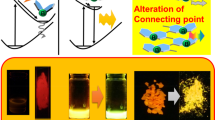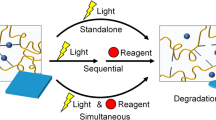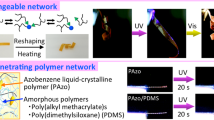Abstract
A photomobile polymer fiber containing anthracene carboxylic acid was prepared from a mixture of commercially available compounds and the photomechanical effects of the fiber were investigated. Upon exposure to UV light, the fiber bent toward the actinic light source owing to [4+4] photodimerization of the anthracene unit, which is similar to that for anthracene side-chain polymers. In addition, the photomechanical properties of the fiber were significantly enhanced by the introduction of liquid-crystalline (LC) properties through the addition of low molecular weight LC acids.
Similar content being viewed by others
Introduction
Photomobile polymer actuators that change their shape or volume in response to actinic light and generate mechanical work have been intensively investigated, because of their high process ability and non-contact-manipulative characteristics.1 Numerous studies on light-driven polymer actuators have been reported and such unique applications as rotor,2 leg,3 lens,4 pump,5 cilia6 and robotic arms7 have been proposed. These compounds use photochromic compounds as a photoresponsive unit. Photoreactive compounds have also attracted much attention for application as photomobile materials.8, 9, 10, 11 The change in physical properties of photoreactive compounds can be easily traced using spectrometry, owing to significant changes in their chemical structure and thermal stability. Anthracene is a conventional photoreactive compound that can undergo [4+4] photodimerization upon exposure to UV light. The change in the chemical structure is sufficiently large to induce macroscopic movement in the crystal state.8 We have previously studied photomobile polymers and achieved light-driven deformation of anthracene polymers. The photomechanical effects of the polymers were strongly affected by the glass transition temperature, which was successfully exploited to program deformation of the shape.12 Furthermore, we have reported that introduction of liquid crystal (LC) properties into anthracene polymers can enhance their photomechanical properties.13 In this work, we have focused on a supramolecular complex containing photoreactive moieties to introduce non-chemical bonding. The formation of a polymer complex from inexpensive polymers and functional materials is useful, because many advantages of polymers can be introduced into low molecular weight functional materials without synthetic modification. Poly-(4-vinylpyridine) (P4VP) can easily form a supramolecular complex with various functional materials containing acidic moieties and the complex exhibits behavior that reflects the functionality of the side-chain polymers.14 Zhao et al. induced a photomechanical effect in P4VP connected to coumarin derivatives by hydrogen bonding.11 The polymer complex film bent toward an actinic light source (310 nm) owing to photodimerization and the subsequent formation of cross-linking, which suggests that the photoreactive moiety can induce photomechanical effects without chemical bonding to the polymer backbone. However, such photomechanical effects have not been evaluated in anthracene complexes to date. Therefore, we have prepared a P4VP complex containing anthracene and investigated the photomechanical effects. In addition, a low molecular weight LC complex was introduced to enhance the photomechanical effect.
Materials and methods
Compounds
Figure 1 shows the chemical structures of the compounds used in this study. Trans-4-butylcyclohexanecarboxylic acid (BCHA) was purchased from Kanto Kagaku (Kanagawa, Japan), P4VP (typically Mw=60 000) was purchased from Sigma Aldrich (St Louis, MO, USA) and other materials were procured from Tokyo Kasei (Tokyo, Japan). Materials and solvents were used without further purification. The complex was prepared by dissolving the compounds in methanol and drying under reduced pressure overnight. The fiber was prepared according to a previously reported method,15 where a small amount of the complex was heated to 130 °C on a glass substrate placed on a hot stage, and the tip of a pick was then dipped into the complex and drawn out to produce the fiber.
Equipment
Hydrogen bonding of the complexes was investigated using Fourier transform infrared spectroscopy (FT-IR; Jasco, Tokyo, Japan, FT-IR 410). The thermotropic properties of the complexes were evaluated by differential scanning calorimetry (DSC; Seiko, SSC5200) at a heating/cooling rate of 10 °C min−1. Films of the complex were prepared by spin-coating thin films from methanol solution. The surface topology and thickness of the films were measured with an interferometric surface profiler (Ryoka System, Tokyo, Japan, VertScan R3300H). UV-vis absorption spectra were measured using a spectrometer (Hitachi, Tokyo, Japan, U-3010) and fluorescence spectra were obtained with a luminescence spectrometer (Hitachi, F-4500). The optical anisotropy of the fiber was observed with a polarizing optical microscope (POM; Olympus, Tokyo, Japan; BX-51P). The photoinduced change in the macroscopic shape of the fibers was observed upon irradiation with UV light at 365 nm from a UV-LED irradiator (Keyence (Osaka, Japan) UV-400 with UV-50H, Dynatech (Kanagawa, Japan) LS500H) and recorded with a digital camera. The degree of fiber contraction was measured with a thermomechanical analyzer (TMA; Seiko (Chiba, Japan) SS6100) using the static stretch mode under photo irradiation. The fiber was fixed at both ends on the apparatus with instant glue and loaded at 3 mN as an initial stress. Fibers with high anisotropy and diameters of 200 μm (as evaluated by POM) were used for the TMA measurements.
Results and Discussion
Photoreactivity of the Complex
A complex film was first prepared from 9-anthracene carboxylic acid and P4VP in a 1:10 molar ratio for evaluation of the photoreactivity. The prepared film was transparent and exhibited blue emission upon exposure to UV light. FT-IR spectra of 9-anthracene carboxylic acid, P4VP and the complex dispersed in KBr are presented in Figure 2. Weak and broad bands around 2500 and 1900 cm−1 were evident for the complex film, which correspond to the absorption of OH hydrogen bonded with the nitrogen atom on the pyridine ring. These bands were not observed for 9-anthracene carboxylic acid and P4VP, which indicates that hydrogen bonding was formed between the pyridine ring and anthracene. These new H-bonded absorption bands have been observed in other pyridine-containing materials with carboxylic acids.16, 17, 18 Figure 3a shows the change in the absorption spectrum of the complex upon exposure with 365 nm light. Peaks around 365 nm were reduced upon illumination with the actinic light. The degree of photoreaction ΔP, was defined according to the following equation for evaluation of the photoreactivity.

where A0 and AUV represent the absorbance of the film before and under photo irradiation, respectively. ΔP was increased because of [4+4] photoreaction under UV light irradiation, although the photoreactivity was not high (Figure 3b). The complex film exhibited photoluminescence upon exposure to 365 nm light, whereas the photoreacted film did not show photoluminescence (Figure 4a). In addition, the irradiated film had no obvious reversion of the absorbance over several months, which indicates that anthracene in the complex underwent photo dimerization similar to that for anthracene connected to a polymer backbone by chemical bonding. Therefore, the complex film was irradiated through a photomask with similar thickness. The film was homogeneous and had no obvious change in structure under ambient light; however, the film exhibited patterned photoluminescence upon exposure to UV light (Figure 4b). Furthermore, the masked pattern appeared after the film was washed with methanol (see Supplementary Information S1). The peak region was equivalent to the non-photoluminescent, photoreacted area, which suggests that the photo-dimerized anthracenes are partly cross-linked with the P4VP polymer backbone by hydrogen bonding.
Enhancement of photomechanical property by introduction of LC moiety
BCHA was added to the complex to introduce LC properties. We have previously reported that LC moieties in the side-chain enhance the photomechanical properties of anthracene polymer fiber.13 The thermal properties of the complex containing BCHA in different ratios are summarized in Table 1. BCHA is a simple acidic LC compound that has a LC phase from 40 to 92 °C. The glass transition temperature of the complex decreased with increase in the BCHA content, and the complex exhibited a typical schlieren texture without segregation and crystallization of the LC dopant (See Supplementary Information S2). Figure 5 shows the change in the ΔP of complex films with various BCHA content at room temperature and the corresponding glass transition temperatures. The complex with high BCHA loading exhibited fast rapid and high photoreactivity at room temperature compared with that for the non-LC complex. In addition, the entire complex showed similar photoreactivity upon heating above their glass transition temperature. Moreover, the similar photoreactivity was observed when we used mixture of trans- and cis- BCHA that does not show any mesophase suggesting that the LC properties do not affect the photoreactivity. In contrast, little enhancement in photoreactivity was observed when crotonic acid (an unsaturated carboxylic acid) was added to the complex instead of BCHA, even though the glass transition temperature was almost the same as the corresponding BCHA-doped complex (see Supplementary Information S4), which indicates that the LC acid acts as a plasticizer,19 however, the structure of the acid also has an important role in enhancement of the photoreactivity.
Photomechanical Effects of the Complex
The photoresponsive behavior of the complex is similar to the side chain of anthracene polymers; therefore, a fiber was prepared from a melt of the complex. It has been reported that aligned anthracene polymer fiber bends toward an actinic light source (UV irradiation).12, 13, 19 Figure 6a shows photographs of a non-LC anthracene P4VP complex fiber before and after photo irradiation. The partly freestanding fiber bowed toward the actinic light source (at 200 mW cm−2) irradiated from above, although the positional change was quite small. In contrast, the macroscopic movement of the fiber was significantly enhanced by the addition of BCHA. Figure 6b shows the macroscopic response of the P163 fiber upon exposure to UV light. The fiber bent over 90° within 10 s under the same experimental conditions as that for the non-LC complex fiber, which suggests that photomobile polymer materials can be obtained and their mechanical response enhanced using commercially available compounds. Figure 7 compares the change in length (ΔL) of the fiber along the longitudinal axis with time of UV irradiation. The degree of deformation ΔL, was defined according to the following equation:

where L0 and LUV describe the length of the fiber before and after photo irradiation, respectively. All the complex fiber exhibited rapid expansion and a subsequently slow contraction upon exposure to UV light. Although the fiber showed similar behavior, the change in length of the LC-complex fiber increased with an increase in BCHA content. Especially, ΔL became saturated after 30 min and reached −1.5% upon exposure to UV light in P163 fiber.
Conclusion
A photoreactive complex fiber was prepared from P4VP and photoreactive carboxylic acid. Upon exposure to UV light, the fiber bent toward the actinic light source because of photoreaction and subsequent deformation of polymer backbone. The photoreactivity and photomechanical effects were enhanced by introduction of a low molecular weight liquid crystal. The complex fiber could be easily applied for mechanical drawing processes, such as wet spinning20 and electrospinning,21 because the fibers exhibit a large photomechanical effect and can be prepared from a simple mixture of commercially available (and inexpensive) compounds.
References
Ikeda, T., Mamiya, J. & Yu, Y. Photomechanics of liquid-crystalline elastomers and other polymers. Angew. Chem. Int. Ed. 46, 506–528 (2007).
Yamada, M., Kondo, M., Mamiya, J., Yu, Y., Kinoshita, M., Barrett, C. J. & Ikeda, T. Photomobile polymer materials: towards light-driven plastic motors. Angew. Chem. Int. Ed. 47, 4986–4988 (2008).
Yamada, M., Kondo, M., Miyasato, R., Naka, Y., Mamiya, J., Kinoshita, M., Shishido, A., Yu, Y., Barrett, J. C. & Ikeda, T. Photomobile polymer materials—various three-dimensional movements. J. Mater. Chem. 19, 60–62 (2009).
Xu, S., Ren, H., Lin, Y., Moharam, M. G. J., Wu, S. & Tabiryan, N. Adaptive liquid lens actuated by photo-polymer. Opt. Express 17, 17590–17595 (2009).
Chen, M., Xing, X., Liu, Z., Zhu, Y., Liu, H., Yu, Y. & Cheng, F. Photodeformable polymer material: towards light-driven micropump applications. Appl. Phys. A 100, 39–43 (2010).
van Oosten, C. L., Bastiaansen, C. W. M. & Broer, D. J. Printed artificial cilia from liquid-crystal network actuators modularly driven by light. Nat. Mater. 8, 677–682 (2009).
Cheng, F., Yin, R., Zhang, Y., Yen, C. & Yu, Y. Fully plastic microrobots which manipulate objects using only visible light. Soft Mater. 6, 3447–3449 (2010).
Al-Kaysi, R. O. & Bardeen, C. J. Reversible photoinduced shape changes of crystalline organic nanorods. Adv. Mater. 19, 1776–1280 (2007).
Naumov, P., Kowalik, J., Solntsev, K. M., Baldridge, A., Moon, J., Kranz, C. & Tolbert, L. M. Topochemistry and photomechanical effects in crystals of green fluorescent protein-like chromophores: effects of hydrogen bonding and crystal packing. J. Am. Chem. Soc. 132, 5845–5857 (2010).
Yasaki, K., Suzuki, T., Yazawa, K., Kaneko, D. & Kaneko, T. Effects of double photoreactions on polycoumarate photomechanics. J. Polym. Sci. A 49, 1112–1118 (2011).
He, J., Zhao, Y. & Zhao, Y. Photoinduced bending of a coumarin-containing supramolecular polymer. Soft Mater. 5, 308–310 (2009).
Kondo, M., Matsuda, T., Fukae, R. & Kawatsuki, N. Photoinduced deformation of polymer fibers with anthracene side groups. Chem. Lett. 39, 234–235 (2010).
Kondo, M., Takemoto, M., Matsuda, T., Fukae, R. & Kawatsuki, N. Preparation and macroscopic deformation of liquid-crystalline polymer fibers crosslinked with anthracene side chains. Mol. Cryst Liq. Cryst. 550, 98–104 (2011).
Gao, J., He, Y., Liu, F., Zhang, X., Wang, Z. & Wang, X. Azobenzene-containing supramolecular side-chain polymer films for laser-induced surface relief gratings. Chem. Mater. 19, 3877–3881 (2007).
Naciri, J., Srinivasan, A., Jeon, H., Nikolov, N., Keller, P. & Ratna, B. R. Nematic elastomer fiber actuator. Macromolecules 36, 8499–8505 (2003).
Kato, T. & Frchet, J. M. J. Stabilization of a liquid-crystalline phase through noncovalent interaction with a polymer side chain. Macromolecules 22, 3818–3819 (1989).
Kumar, U., Kato, T. & Fréchet, J. M. J. Use of intermolecular hydrogen bonding for the induction of liquid crystallinity in the side chain of polysiloxanes. J. Am. Chem. Soc. 114, 10093 (1992).
Kato, T., Hirota, N., Fujishima, A. & Frechet, J. M. J. Supramolecular hydrogen-bonded liquid-crystalline polymer complexes. Design of side-chain polymers and a host-guest system by non-covalent interaction. J. Polym. Sci. Part A: Polym. Chem. 34, 57–62 (1996).
Kondo, M., Takemoto, M., Matsuda, T., Fukae, R. & Kawatsuki, N. Photoinduced change in mechanical properties of anthracene polymers containing flexible side chains. Bull. Chem. Soc. Jpn. 83, 1333–1337 (2010).
Ohm, C., Morys, M. F., Forst, R., Braun, L., Eremin, A., Serra, C., Stannarius, R. & Zentel, R. Preparation of actuating fibres of oriented main-chain liquid crystalline elastomers by a wetspinning process. Soft Mater. 7, 3730–3734 (2011).
Krause, S., Dersch, R., Wendorff, J. & Finkelmann, H. Photocrosslinkable liquid crystal main-chain polymers: Thin films and electrospinning. Macromol. Rapid Commun. 28, 2062–2068 (2007).
Acknowledgements
This work was supported in part by a Grant-in-Aid for Scientific Research in Priority Areas ‘New Frontiers in Photochromism (No. 471)’ from the Ministry of Education, Culture, Sports, Science and Technology (MEXT) of Japan, a Grant-in-Aid for Scientific Research (S, No. 21225006) from the Japan Society for the Promotion of Science, and a research grant from The Mazda foundation and The Iketani Foundation.
Author information
Authors and Affiliations
Corresponding author
Additional information
Supplementary Information accompanies the paper on Polymer Journal website
Supplementary information
Rights and permissions
About this article
Cite this article
Kondo, M., Takemoto, M., Fukae, R. et al. Photomobile polymers from commercially available compounds: photoinduced deformation of side-chain polymers containing hydrogen-bonded photoreactive compounds. Polym J 44, 410–414 (2012). https://doi.org/10.1038/pj.2011.148
Received:
Revised:
Accepted:
Published:
Issue Date:
DOI: https://doi.org/10.1038/pj.2011.148
Keywords
This article is cited by
-
Photomechanical materials driven by photoisomerization or photodimerization
Polymer Journal (2020)










